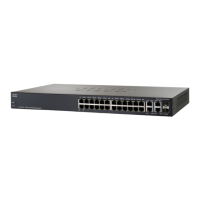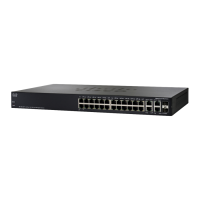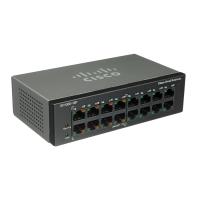Spanning Tree
Configuring STP Status and Global Settings
232 Cisco Small Business 200, 300 and 500 Series Managed Switch Administration Guide (Internal Version)
14
The device supports the following Spanning Tree Protocol versions:
• Classic STP – Provides a single path between any two end stations, avoiding
and eliminating loops.
• Rapid STP (RSTP) – Detects network topologies to provide faster
convergence of the spanning tree. This is most effective when the network
topology is naturally tree-structured, and therefore faster convergence
might be possible. RSTP is enabled by default.
• Multiple STP (MSTP) – MSTP is based on RSTP. It detects Layer 2 loops, and
attempts to mitigate them by preventing the involved port from transmitting
traffic. Since loops exist on a per-Layer 2-domain basis, a situation can occur
where there is a loop in VLAN A and no loop in VLAN B. If both VLANs are on
Port X, and STP wants to mitigate the loop, it stops traffic on the entire port,
including VLAN B traffic.
MSTP solves this problem by enabling several STP instances, so that it is
possible to detect and mitigate loops separately in each instance. By
associating instances to VLANs, each instance is associated with the
Layer 2 domain on which it performs loop detection and mitigation. This
enables a port to be stopped in one instance, such as traffic from VLAN A
that is causing a loop, while traffic can remain active in another domain
where no loop was seen, such as on VLAN B.
Configuring STP Status and Global Settings
The STP Status and Global Settings page contains parameters for enabling STP,
RSTP, or MSTP.
Use the STP Interface Settings page, RSTP Interface Settings page, and MSTP
Properties page to configure each mode, respectively.
To set the STP status and global settings:
STEP 1 Click Spanning Tree > STP Status & Global Settings.
STEP 2 Enter the parameters.
Global Settings:
• Spanning Tree State—Enable or disable STP on the device.
• STP Operation Mode—Select an STP mode.

